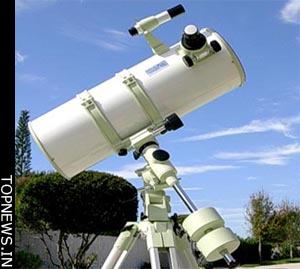Telescopes reveal chaotic and overcrowded stellar nursery
 Washington, April 21: Astronomers, using different telescopes, have found that the well-known Great Nebula of Orion, which is a stellar nursery of sorts, is a lively and overcrowded place, with young stars emitting gas jets in all directions, creating quite a chaotic picture.
Washington, April 21: Astronomers, using different telescopes, have found that the well-known Great Nebula of Orion, which is a stellar nursery of sorts, is a lively and overcrowded place, with young stars emitting gas jets in all directions, creating quite a chaotic picture.
This was observed by astronomers using the United Kingdom Infrared Telescope (UKIRT) in Hawaii, the IRAM Millimeter-wave Telescope in Spain, and the Spitzer Space Telescope in orbit above the Earth.
With the naked eye, one can only see the brightest stars, like Betelgeuse and Rigel at the shoulder and knee of the constellation, or perhaps the Orion Nebula as a vaguely fuzzy patch around the sword.
What the eye does not see is an enormous cloud of molecules and dust particles that hide a vast region where young stars are currently being born.
On the sky, the region - known to astronomers as the Orion Molecular Cloud - is more than 20 times the angular size of the full moon.
It is one of the most intense regions of star formation in the local Milky Way and has been the subject of many small-scale studies over the years.
However, the current work is the first to present such a complete study of the young stars, the cloud of gas and dust from which they are being born, and the spectacular supersonic jets of hydrogen molecules being launched from the poles of each star.
Tom Megeath, an astronomer from the University of Toledo, provided a catalogue of the positions of the very youngest stars - sources revealed only recently by the Spitzer Space Telescope.
Thomas Stanke, a researcher based at the European Southern Observatory in Garching, Germany, then provided extensive IRAM maps of the molecular gas and dust across the Orion cloud.
Dirk Froebrich, a lecturer at the University of Kent, later used archival images from the Calar Alto Observatory in Spain to measure the speeds and directions of a large number of jets by comparing them with their positions in the new images.
Armed with these data, Davis was able to match the jets up to the young stars that drive them, as well as to density peaks within the cloud - the natal cores from which each star is being created.
According to Dr Davis, "Regions like this are usually referred to as stellar nurseries, but we have shown that this one is not being well run: it is chaotic and seriously overcrowded." (ANI)